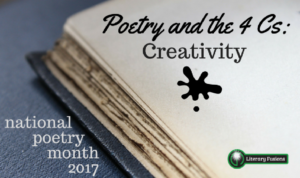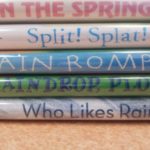 The world after K-12 (whether workforce or higher education) is asking more from our students – they must be creative and innovative. We see that reflected in the trends in education: BreakoutEDU, makerspaces, Genius Hour, etc.
The world after K-12 (whether workforce or higher education) is asking more from our students – they must be creative and innovative. We see that reflected in the trends in education: BreakoutEDU, makerspaces, Genius Hour, etc.
(Looking for the other 3 Cs? Communication and Critical Thinking, Collaboration – check them out!)
Creativity is one of the things makes people unique, it allows people to realize they don’t have to be exactly like everyone else. The confines of today’s rigorous curriculum make it difficult for students to express anything but the “right answer” before it’s time to move on, and so many students have become conditioned to answering questions the way they think they’re supposed to. However, which do YOU find more satisfying: answering a question the right way, or developing a new line of thought? The ability to create comes with an incredible sense of satisfaction.
While some creativity certainly is natural, it is also a skill, the practice of which can have numerous benefits for your students:
- Increased confidence
- Better social skills
- Deeper engagement with content
- Ownership
- Engagement
- Motivation
As teachers, our lessons need to allow room for and foster creativity! Structure has its place (we have curriculum to cover!) and might feel more stressful for the teacher, but giving students the freedom to put their own twist or signature style into their learning will be completely worth it in the end.
This is probably the easiest and most fun of all the 4 Cs! It would be a bit contradictory to provide a list of approved ways to be creative, so we’ve gathered a few ideas to get your wheels turning. Ultimately, let your students get creative with poetry!
“Found Poetry” – Poems created from text that already exists.
 Blackout Poetry. Instead of starting with a scary blank page, why not start writing a poem with a page full of words? Using a page from an old book or a newspaper or magazine, the author uses a marker to “blackout” words until a poem emerges. “The words for blackout poems are already written on the page, but it’s up to the blackout poet to bring new meaning and life to these words” (https://www.scholastic.com/teachers/blog-posts/john-depasquale/blackout-poetry/).This can be a fun, sometimes challenging, way to stretch students’ understanding of poetry!
Blackout Poetry. Instead of starting with a scary blank page, why not start writing a poem with a page full of words? Using a page from an old book or a newspaper or magazine, the author uses a marker to “blackout” words until a poem emerges. “The words for blackout poems are already written on the page, but it’s up to the blackout poet to bring new meaning and life to these words” (https://www.scholastic.com/teachers/blog-posts/john-depasquale/blackout-poetry/).This can be a fun, sometimes challenging, way to stretch students’ understanding of poetry!- Book Spine Poetry. Similarly, instead of starting with a page full of words, you can start with phrases using book titles. Turn students loose in the library or your classroom library and let them create a stack of books that, when you look at the titles in order, creates a poem. Leave the stacks of books out as decoration!
Digital Poetry: Visual
- Big Huge Labs – Motivator: https://bighugelabs.com/motivator.php. Use this tool to add an image to a short poem in the style of motivational posters. (There are other tools as well to help you be creative!)
- Storybird: https://storybird.com/educators/. “Starting with pictures,” students draw inspiration from provided illustrations to write stories and poems that can be published online. Check out their poetry section: https://storybird.com/read/poetry/. Download their new poetry app that allows you to create magnetic poetry inspired by pictures, Lark: https://storybird.com/lark/.
Digital Poetry: Giving Voice
- Poetry Slam + recording tool: Poetry slams are all about “creation and performance of poetry that engages communities and provides a platform for voices to be heard” (https://poetryslam.com/about/). Using any kind of recording tool (smartphone, tablet, webcam), students could record themselves delivering their poetry. Create a private YouTube Channel to share poetry videos with the class and their parents, and you have a digital poetry slam!
- Micropoetry or Twikaiku: With a 140-character limit, Twitter has become an ideal platform for “publishing” haikus. Using the hashtag #haiku (be sure to screen the current content ahead of time, if at all possible, or pick out a few that are appropriate!), students can both consume and contribute to a global body of poetry. Read more about this creative trend:https://www.theatlantic.com/technology/archive/2013/06/twitter-is-the-new-haiku/277405/









Leave a Reply